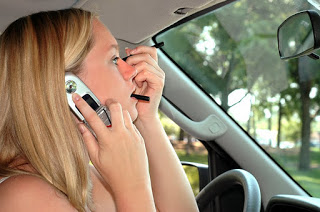
Teens and Distracted Driving
May 14, 2009
Car crashes are the number one killer of American teens, and the primary cause of fatal teen crashes is driver error. Driver distraction is included in the broad category of driver error. Though not every distracted teen driver is involved in a crash, distraction increases the risk of either causing a collision or being unable to avoid one. And though distracted driving is a problem for any driver, it is of special concern for inexperienced drivers, who may be distracted more easily and for longer periods of time and who may have difficulty controlling the vehicle even under normal conditions.
Modern diversions such as cell phones and other technical equipment are simply additions to traditional distractions such as eating, reading, dealing with passengers, reaching for objects, and looking at things or people outside of the vehicle. Dealing with passengers is one of the most frequently reported causes of distracted driving, and lively teen passengers can be particularly distracting to new drivers. Distracted driving is nothing new, but educational efforts to combat it are increasing.
It’s important to realize that when you’re driving, you’re already multitasking, because you are:
- Trying to control a large machine at high speed.
- Responding to the driving environment, including road and weather conditions, other traffic, and road signs and signals.
- Reacting to changing conditions, such as other drivers pulling out in front of you and pedestrians crossing the road ahead.
Adding another task to this list might be just enough to make you lose control of your vehicle or fail to act in time to prevent a collision.
The following tips will help prevent distracted driving:
- Increase your awareness of both physical and mental distractions. Physical distractions occur when you take your hands off the wheel and/or your eyes off the road. They happen when you adjust your stereo, take a drink of water, or reach for an object that has fallen on the floor. Mental distractions are sometimes more difficult to identify, because they don’t necessarily interfere with the physical act of driving. They occur when you argue or even laugh with a passenger, receive surprising or interesting news on your cell phone, or are preoccupied with a problem at school or work.
- Minimize the need for adjusting controls while you are driving. Take a few moments to prepare for your trip when you enter the vehicle. Adjust the seat position, climate control, stereo, and other devices before you leave your driveway or parking spot. If you are driving an unfamiliar vehicle, spend a few extra seconds locating the controls so you won’t need to look for them while you are driving.
- Review driving directions and maps, enter your destination into your navigation system and check traffic conditions before you leave. If you have a passenger, she or he can act as your navigator. Avoid sudden stop and turns while on the road by pulling over in a safe place, off the road and away from traffic, if you get confused or lost.
- Pull over to a safe place, off the road and away from traffic, to talk on the phone, text message or email. Using hands-free equipment is not safe enough because of the likelihood of mental distraction. Turn the phone off before you start out to reduce temptation.
- Stop at restaurants to eat or drink. Unwrapping food and condiment packages, reaching into bags, and having greasy fingertips are physical distractions. Realizing that you got the wrong sandwich is a mental distraction that is difficult to correct once you’ve left a drive-through window. Spilling coffee on your new shirt qualifies as both a physical and a mental distraction. Reduce your risk of a crash and your stress level by taking a few minutes to enjoy your meal outside of your vehicle.
- Keep in mind that your vehicle’s mirrors exist to help you view traffic, not yourself. Don’t use them for personal grooming while the vehicle is in motion.
As a driver, your only task when you enter your vehicle is to arrive safely at your destination. Anything else can be taken care of when you arrive. As a new driver, begin developing good habits right away by avoiding distractions and concentrating on your driving.
